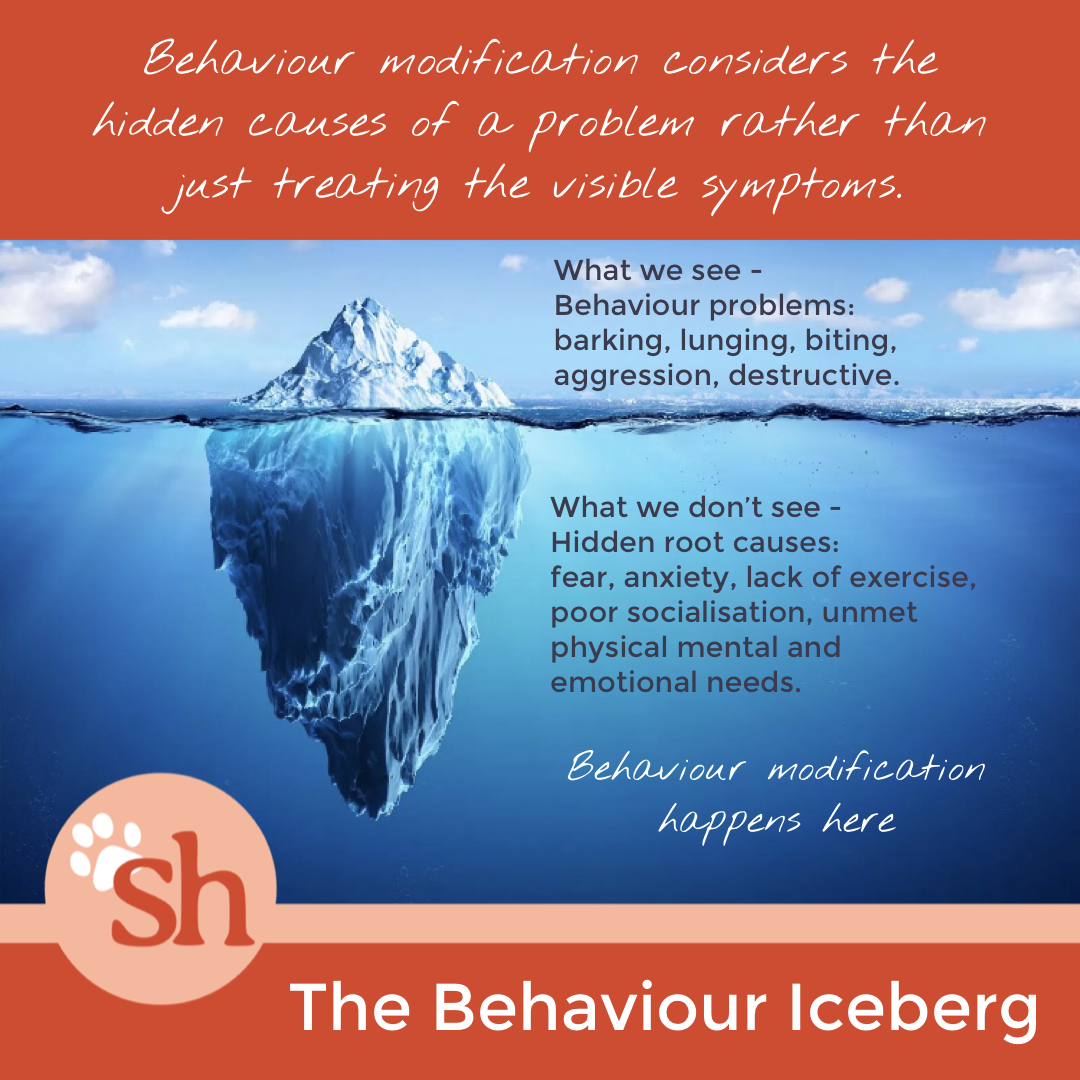Understanding the ‘Behaviour Iceberg’: Why Dog Behaviour Is More Than Meets the Eye
As a clinical animal behaviourist, one of the very first things I do in a consultation is introduce something I call the Behaviour Iceberg. It’s a simple but powerful visual tool that helps dog owners understand that the behaviours they’re concerned about — whether it’s barking, growling, lunging, whimpering, or clinginess — are just the tip of the iceberg.
These visible behaviours are important, of course, but they’re only a small part of the story. What we’re really interested in is what’s going on beneath the surface — the root causes that are driving those behaviours. Because if we want to truly help the dog (and their human), we need to explore the emotional, physical, and environmental factors that may be influencing how the dog feels and responds.
Understanding this concept helps shift the focus from simply “stopping” a behaviour, to understanding it — and that’s where lasting, meaningful change begins.
What’s at the Tip of the Iceberg?
We tend to notice the more obvious, reactive behaviours first — the ones that are disruptive or draw attention:
Barking
Growling
Lunging
Snapping or biting
But many dogs communicate their distress in far quieter, more subtle ways:
Whimpering or whining
Pacing or panting with no clear cause
Clinginess or being unable to settle alone
Hypervigilance — constantly watching or listening
Restlessness or agitation
Avoiding interaction or withdrawing from contact
These behaviours are just as significant as the louder ones. In fact, subtle signs of stress or emotional discomfort are often overlooked or misinterpreted. A dog that’s constantly following their owner around might be labelled as “needy,” when in reality they’re feeling insecure or anxious. A dog who whines frequently may be in discomfort, or confused about what’s expected of them.
Recognising these quieter signs is just as important as addressing the more dramatic behaviours.
What’s Beneath the Surface?
Dog behaviour is rarely caused by one single issue. More often, there are multiple interrelated factors contributing to how a dog feels and behaves. These factors are usually invisible at first glance, but they hold the key to understanding the whole picture.
Some of the common underlying influences include:
Pain or undiagnosed medical issues
Stress, fear, or anxiety
Frustration or lack of mental stimulation
Previous trauma or negative experiences
Lack of early socialisation or developmental gaps
Genetic predispositions or breed-specific tendencies
Changes in environment or routine
Confusing communication or unclear expectations from humans
Unintentionally reinforced behaviours
Each dog is an individual, and each of these elements may play a part to varying degrees. Without being able to ask the dog directly, we can’t always know exactly what’s going on — but a thorough behavioural assessment helps us piece together the puzzle and make educated, compassionate decisions about how best to help.
Why the Behaviour Iceberg Matters
When we only focus on what’s visible — the barking, the growling, the whining — we risk:
Punishing a dog for expressing distress
Suppressing behaviours without resolving the cause
Misinterpreting a dog’s needs or emotional state
Making the behaviour worse through stress or confusion
By taking the time to look beneath the surface, we move from reaction to understanding. We begin asking the most important question in behaviour work:
Why is this dog behaving this way?
That’s where the real progress happens. Not in stopping a behaviour at all costs, but in understanding what that behaviour is telling us — and what the dog really needs in order to feel safe, understood, and supported.
How a Clinical Animal Behaviourist Can Help
Uncovering the unseen causes of a dog’s behaviour isn’t always straightforward — and it’s not something owners are expected to figure out on their own.
As a clinical animal behaviourist, my role is to work alongside you to explore what might be going on beneath the surface. Through a detailed assessment of your dog’s behaviour, history, environment, and health, we can begin to identify the underlying factors contributing to the issues you’re seeing.
Together, we’ll create a tailored behaviour plan that not only addresses the symptoms, but supports your dog’s emotional and physical wellbeing at a deeper level. This might involve changes to routine, training approaches, enrichment, communication, or working collaboratively with your vet or other professionals.
Whether your dog’s behaviour is loud and obvious or quiet and subtle, compassionate and evidence-based support can make a real difference — for both you and your dog.
Final Thoughts: Listening Beyond the Behaviour
Whether a dog is barking at strangers, refusing to be left alone, or simply following their person from room to room, they’re communicating something important. Behaviour is never random. It’s always a reflection of the dog’s internal state.
The Behaviour Iceberg is a reminder to look deeper — to explore what’s going on beneath the surface, rather than focusing only on what we see above the waterline. As behaviour professionals, guardians, and dog lovers, our job isn’t just to manage behaviour — it’s to understand it.
Because when we start with empathy and curiosity, everything else becomes possible.

